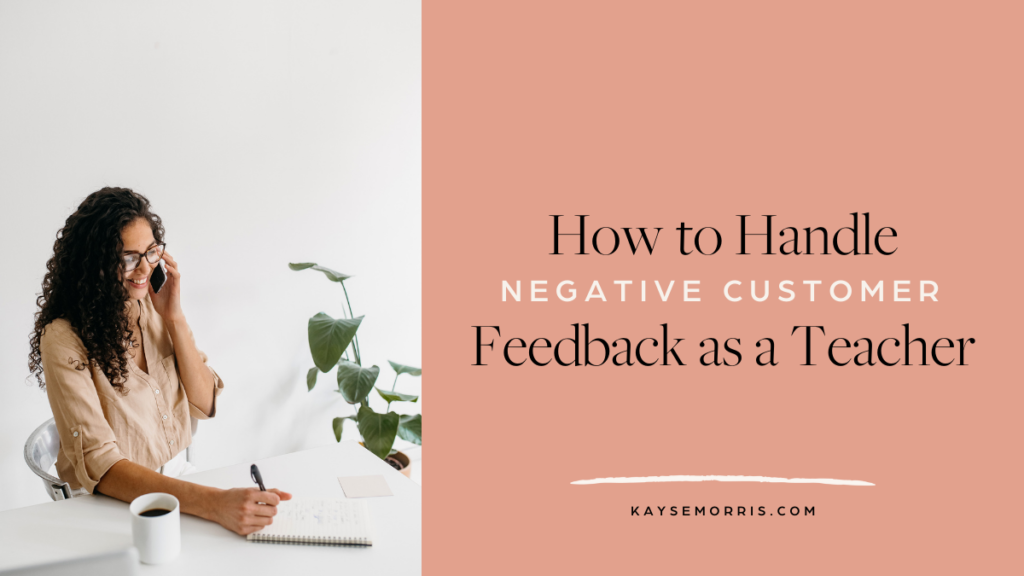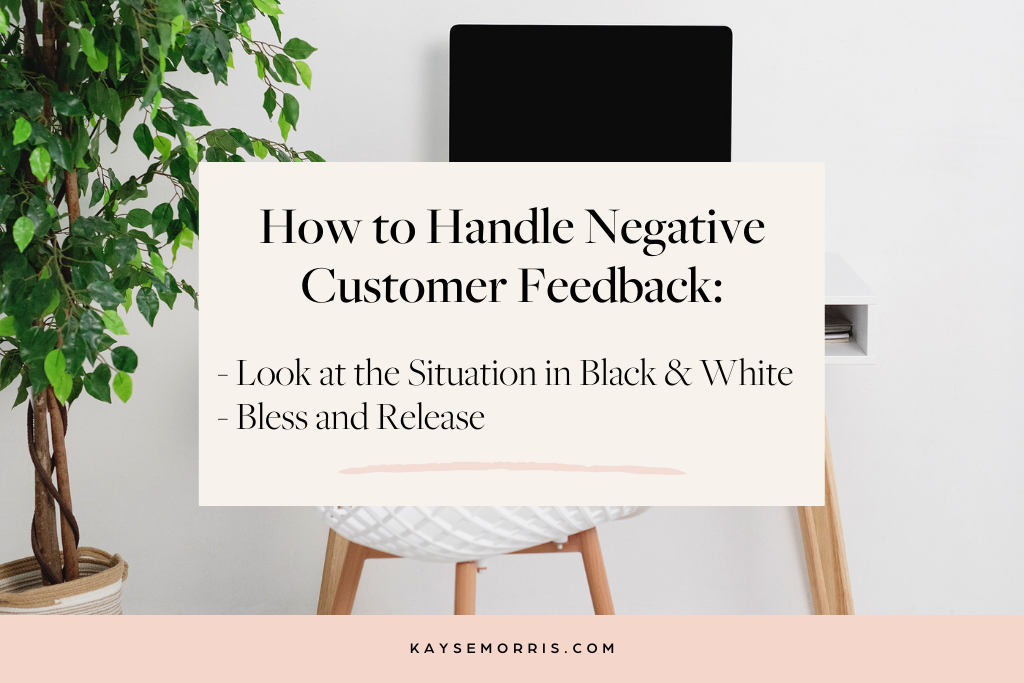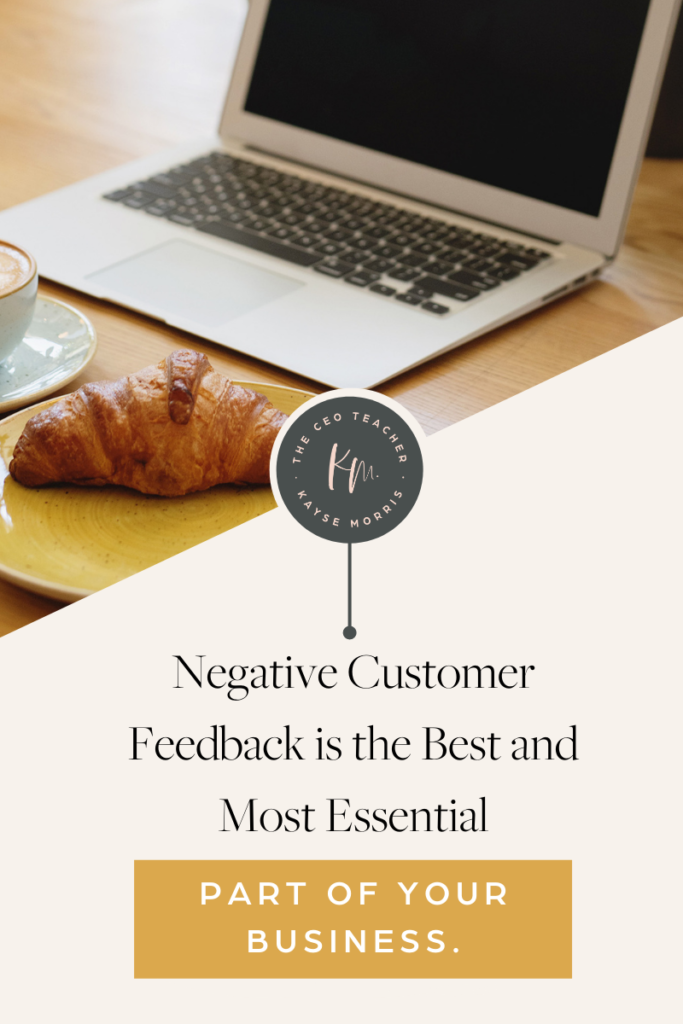How to Handle Negative Customer Feedback as a Teacher
Every CEO Teacher® has to learn how to handle negative customer feedback. Do you get nervous every time your TpT app alerts you that you have a new product review? Or maybe you have a pit of dread in your stomach each time you open your business email inbox? We, teachers, don’t like negative feedback! We want to make everyone happy. What if I tell you that negative customer feedback isn’t just inevitable; it’s actually essential to a thriving business?!

Robin Sharma says, “Negative feedback can make us bitter or better.” If you are ever looking for a great read as a CEO Teacher®, check out anything he writes. The 5 am Club and The Everyday Hero Manifesto. He’s deep, but I like it. He gave one of the most profound interviews I have ever heard on The School of Greatness Podcast with Lewis Howes. It is one of those where you have to stop it, rewind it, clap and say amen, and rewind and relisten. I am in awe of someone that can speak on demand about such deep topics – that’s when you know his teachings are real – they are engrained in him, and I truly admire that.
You know how much I love sharing my strategies with you through this blog and my podcast. Did you know you can get coached by me for free?! I don’t offer one-on-one coaching anymore, but I do coach our podcast listeners each week at the end of our show. We call these “CEO Teachers® in Training.”
All you have to do to get in on this is to go wherever you listen to podcasts and leave a quick review about your thoughts on The CEO Teacher® Podcast. At the end of your review, you can ask me a question. We pull a question from these reviews for each show, and I go in-depth with you and answer your question. Leaving a review for our show allows other teachers to find us, and it’s our life’s work to serve teachers from all over the world. Thank you for helping make that dream happen.
My First Time Receiving Negative Customer Feedback
Shaky hands, nervous stomach, no appetite, mind racing, tears, anger – those are just a few of the feelings that I used to get when I received negative customer feedback. I specifically remember the first time I got a negative review on Teachers Pay Teachers. I was walking my 8th graders to the lunchroom, and my phone was in my back pocket. They all got through the line, and I went to warm up my Lean Cuisine. I used to think eating a Lean Cuisine pizza every day for lunch with a Diet Coke was healthy. No wonder my hair was falling out. Anyway, I digress.
I’m standing in front of the microwave when my phone buzzes, and I pull it out of my back pocket and see it. This was back before the TpT app, so I had received an email with TpT feedback! High kicks! I love getting feedback because, at this time, my store was relatively new, and getting feedback is kind of hard to come by. So I opened up the email and saw it—my first negative customer feedback on a TpT product.
If I Knew Then What I Know Now…
I wish I could go back and find exactly what it said because I’m sure I was being hella dramatic. It probably wasn’t even that serious, but I legitimately thought my day was over. I couldn’t eat, my palms were sweaty, I teared up then got mad. “How dare they say anything about something I worked so hard on. I’m gonna show them! They don’t even know how long that took me, and if they said there was an error, I gotta triple check this and fix it ASAP because what if someone else sees it, and THEY leave a bad review too?”
Hahaha! That was how I used to approach negative feedback in business. I’m happy to report that I feel absolutely none of those feelings or emotions anymore when we receive negative customer feedback. And, I want to share some actionable steps you can take to release the anxiety and use negative customer feedback to improve your overall business and become happier as the creator and designer you were born to be.
How to Handle Negative Customer Feedback Starts with Your Belief System and Inner Thoughts
Before I get into exactly how we use customer feedback to improve our company, I want to express a new belief system I’ve adopted that’s helped me grow into the business owner I am today. You’ve heard me talk about creating the life you want, right? In episode 171, I discussed the three steps to getting what you want in life. One of those steps is feeling the outcome you want and taking action to get there. The same thing goes for negative emotions you don’t want to feel.
When I was constantly worried about negative customer feedback or what others thought of me, I felt like I got daily affirmations that said: “you aren’t on the right track,” and “this person doesn’t like you.” From negative TpT feedback on products to someone mad in my Instagram DMs to hurtful emails, and even text messages where people would see a post on social media and tell me why they disagreed with it. Yes, that’s all happened.
I was so worried about others' feelings that I forgot to step into my own. Over the last few years, I’ve worked on understanding and feeling what I want out of business and life. I’m happy to say that we barely receive any negative feedback anymore at The CEO Teacher®, but it’s taken a while to get here. Now is that to say we don’t ever receive it because we do and will. If you receive a lot of it, it’s time to evaluate the cause. But, believing in your mission and vision and stepping into what aligns with that without worrying about the fear of customer feedback can be an important part of the growing process.

The Best Advice I Can Give You Regarding Negative Feedback in Business
One more piece of advice I have always wanted to say but have been too afraid to say out loud is this: be very careful who you associate yourself with. You are the face or CEO Teacher® behind your business. You control what you say and do, but you cannot control what others say or do. I don’t care if they are more popular than you or seem to have something you desire. Find your life statement (mission statement), and when someone doesn’t align with that, get out.
Our life statement at Team CEO Teacher® is: “Be a good human, and be good to all people.” If an opportunity isn’t aligned with that, we’re out. No amount of fame or influence can sway that. I don’t care if millions will see me appear on a stage. If the person hosting that stage isn’t a good human or doesn’t treat all people well, it’s a heck no for me. Do not associate yourself with people because of their popularity; it may ruin a reputation you’ve worked hard on.
How to Respond to Negative Customer Feedback in Business
My brother’s advice rings true here. He always tells me, “It’s black or white. It’s not grey.” Even when the lines may seem blurred, when you read any piece of customer feedback, ask yourself, “How can I view this as black and white? If I take myself and my feelings out of this equation, how can I see it for what it truly is?” Here’s how you do that.
Negative Customer Feedback Examples & How to Navigate Them
If the feedback is based on something you can and should improve, regardless of if you think it’s necessary, you do it. For example, “I wish this was easier to navigate. I had a tough time figuring out what page to do first.”
If I read that customer feedback from my grey perspective, I could say, “ Oh man, they just don’t understand what I was thinking. It’s so easy to navigate. You just print it out and start on page 4, duh.”
As a seasoned business owner, I read the customer feedback objectively now and think, “Okay, navigation is a sticky point here, and this person didn’t understand, so I need to improve that. First, I’ll make a clickable table of contents. Then, I’ll create a page that walks them through step by step how to use this product.” No hard feelings, no emotion. It’s a simple black-and-white problem and solution.

Next, ask yourself, “Is this personal?” If we receive negative feedback these days, more times than not, it’s personal. IF someone doesn’t like a decision I’ve made or that I don’t personally respond to their email\, they may hit us with something like, “I’ve sent this email three times and demand a response from Kayse herself. (personal) I don’t appreciate how she (fill in the blank).”
If the negative customer feedback is personal, here are a few questions to ask yourself. First, “What good will come out of this if I respond?” Then, “Can I change their mind?” And finally, “Will this mend the issue?”
Why the “Bless and Release” is the Best Plan of Action
If the answers to those questions are no, bless and release, baby. I say that jokingly, but I mean that in a very straightforward way. When I say bless, I mean that you can discuss it with yourself or your team and recognize their point of view, such as, “ I understand they are upset because I did (fill in the blank), and I hope that they can one day understand.” And the other part, release, means that I tell myself, “There’s nothing I can do to change their mind, so it’s time for me to move on.”
Responding in these types of situations will do more harm than good. Don't respond unless you trust yourself and your responses to be clean and judgment-free, don’t respond. Working as a waitress for eight years helped me with the “The customer is always right” mindset. Now, that’s obviously not a true statement, but you can make them feel they are right, and sometimes that validation is all they need.
How Do You Respond to Negative Customer Feedback as a Whole?
Understand that negative feedback in business is the best and most essential part of your job. You work in a customer-based business, so negative feedback is everything you need to grow and scale your business to run like a well-oiled machine. If everyone loved everything you did all the time, you’d never grow. Growth is what stretches and builds you up to become the best version of yourself.
When you receive negative customer feedback, make a document and put all of the negative feedback from customers in it. Look for patterns and see if anything seems to be consistent. If so, what is it? How can you fix it? Sometimes negative customer feedback is easy to fix, while other times, it’s a progression of fixes.
It took nearly four years to resolve some issues we saw in our company and finally get it right with our two membership programs. But, I wouldn’t have ever figured it out if I didn’t endure negative criticism and feedback from customers. The wrong action I took produced so much clarity that I could easily see the writing on the wall and what I needed to do to improve. And now? Things are better than they’ve ever been.
It Starts With Who You Associate With
Having someone like our integrator, Allie, on our team (who has more kindness and honesty than any other human I’ve ever met) also allowed me to let go of some negative emotions I had. I’ve had employees in the past who would relish in negativity and those types of messages so much that they’d bring them to a meeting and dwell on it.
You will NEVER hear me or our team members speak negatively about any paying customer. If someone is upset, we always find a way to fix it. If someone is mad, we figure out how to remedy the situation. If someone thinks we did a horrible job explaining something, we collaborate and clarify it. If someone doesn’t like the way I responded to an email, how can a team member jump in and use her words to help explain it better?
Focus on the good; see the good. Be a good human, and be good to all people. Thriving after negative customer feedback is how you pave the way to get to the people you are supposed to help.

Often, the fear of failure is attached to the anxiety you may get when you receive negative feedback from customers. Overcome your fear of failure with these four steps!
I chatted a lot about mindset and habits in this post. Learn more about keystone habits and how to shift your mindset here.
And don’t forget to leave a review of The CEO Teacher® Podcast and ask me a question at the end to get coached by me on a future episode! Let’s chat about how to handle negative customer feedback or any other business strategies you have a question about.
Leave a Reply Cancel reply
This site uses Akismet to reduce spam. Learn how your comment data is processed.
Behind-the-Scenes Secrets to TPT Success
This training will not only show you how to make the perfect TPT resource...
l'll also teach you how to make sure it ranks #1 in search (because getting found is how you get paid!) and the secret to rocking your resource marketing!
Seats are limited; sign up now!
3 Steps to Sell Your Resources Like Hotcakes on TPT and Beyond…
save me a spot!
FREE WEBINAR
In this training, I'll show you how to build an online membership in 90 days, so you can have consistent income (in addition to your teaching salary) all year long!


your comments